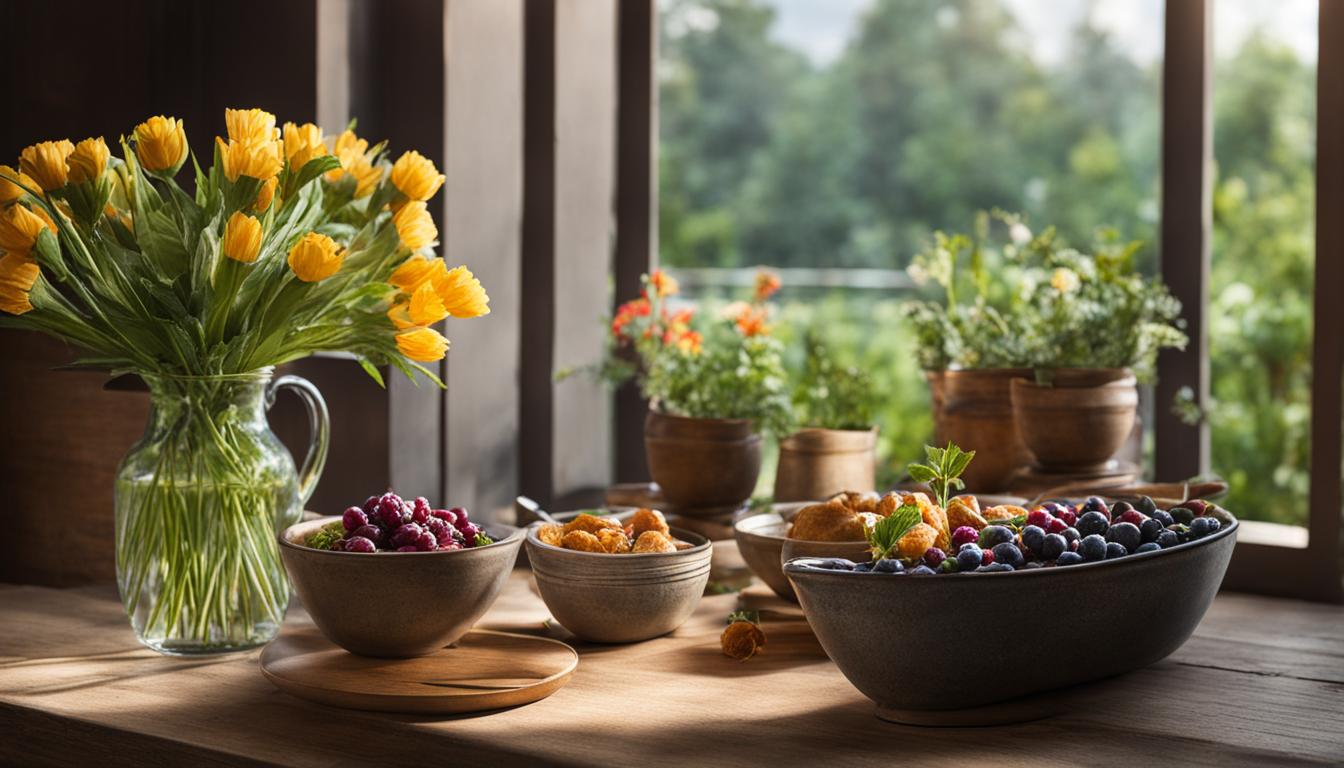In the hustle and bustle of our daily lives, it’s easy to overlook the simple pleasures and blessings that surround us. By consciously shifting our perspective and embracing gratitude, we can find joy in the ordinary moments of life. Cultivating gratitude allows us to recognize the beauty in the present moment and brings forth a sense of contentment and fulfillment. Moreover, practicing gratitude not only benefits our own well-being but also spreads positivity and uplifts others, contributing to a more joyful and compassionate world.
Key Takeaways:
- Practicing gratitude helps us find joy in the simple pleasures of life.
- Cultivating gratitude brings a sense of contentment and fulfillment.
- Gratitude benefits our own well-being and contributes to a more joyful world.
The Power of Appreciation
Gratitude is not just a passing emotion, it is a transformative state of mind. When you embrace gratitude, you shift your focus from what you lack to what you have, cultivating a greater appreciation for the simple pleasures in life. It is a mindset that allows you to see the abundance and beauty that surrounds you, even in challenging times.
The practice of gratitude goes beyond just feeling thankful. It has the power to improve your mental health and well-being. Numerous studies have shown that practicing gratitude can reduce stress, anxiety, and depression. By fostering a positive outlook on life, gratitude helps you navigate difficulties with resilience and optimism.
When you incorporate gratitude into your daily life, you create a mindset that is attuned to the positive aspects of every situation. This not only improves your mental health but also enhances your overall sense of happiness and contentment.
Practicing gratitude is a simple yet profound way to nurture your mental and emotional well-being. By acknowledging and appreciating the good in your life, you create a ripple effect of positivity that can extend to those around you.

The Gratitude Mindset and Mental Health
The link between gratitude and mental health is well-established. Research has shown that individuals who regularly practice gratitude experience lower levels of stress, anxiety, and depression. By focusing on the positive aspects of their lives, these individuals develop a more resilient mindset and are better equipped to cope with adversity.
When you incorporate gratitude into your daily routine, you train your brain to seek out and appreciate the good. This shift in perspective allows you to find joy in the present moment and foster a greater sense of well-being.
Practicing Gratitude
Cultivating a gratitude practice doesn’t have to be complicated. There are many simple yet effective ways to integrate gratitude into your daily life:
- Start a gratitude journal: Take a few minutes each day to write down three things you are grateful for. This practice helps you become more attuned to the positive aspects of your life.
- Express gratitude to others: Take the time to thank the people in your life who have made a positive impact. Write a heartfelt note or simply tell them in person how much you appreciate them.
- Practice gratitude meditation: Set aside a few minutes each day to sit quietly and reflect on the things you are grateful for. Use this time to cultivate a deep sense of gratitude and appreciation.
By embracing the power of appreciation and incorporating gratitude into your daily life, you can experience a profound shift in your mindset and overall well-being.
| Benefits of Practicing Gratitude |
|---|
| Reduces stress, anxiety, and depression |
| Improves overall mental health and well-being |
| Fosters a positive outlook on life |
| Cultivates greater resilience and optimism |
| Enhances overall sense of happiness and contentment |
| Creates a ripple effect of positivity |
The Benefits of Gratitude
The practice of gratitude has profound benefits for your overall well-being and happiness. By cultivating a mindset of thankfulness, you can experience enhanced well-being, increased happiness, improved mental health, better physical health, stronger relationships, and increased resilience. Let’s explore these benefits in more detail:
- Enhanced well-being: Practicing gratitude can significantly improve your overall sense of well-being. When you focus on the positive aspects of your life and express gratitude for them, you cultivate a greater appreciation for what you have, leading to a deeper sense of contentment and fulfillment.
- Increased happiness: Research has shown that regularly practicing gratitude is strongly correlated with increased levels of happiness and life satisfaction. By shifting your focus to the blessings in your life, you can create a positive mindset that fuels happiness and joy.
- Improved mental health: Gratitude has a powerful impact on your mental health. It reduces symptoms of depression and anxiety, enhances emotional well-being, and promotes a positive outlook on life. By acknowledging and appreciating the good in your life, you can counteract negative thought patterns and cultivate a healthier mindset.
- Better physical health: Gratitude not only benefits your mental well-being but also has positive effects on your physical health. Studies have shown that grateful individuals experience better sleep quality, lower levels of stress and inflammation, and improved cardiovascular health.
- Stronger relationships: Expressing gratitude towards others strengthens your relationships and deepens the connection you have with them. When you show appreciation and acknowledge the kindness and support you receive, you foster a sense of mutual respect and gratitude, nurturing stronger and more meaningful bonds.
- Increased resilience: Gratitude plays a crucial role in building resilience. When faced with challenges and adversity, practicing gratitude helps shift your focus towards the positive aspects of your life, enabling you to navigate difficult situations with greater strength and resilience. By acknowledging the silver linings and lessons learned from hardships, you can bounce back and grow stronger.
By embodying gratitude in your daily life, you can unlock these incredible benefits and cultivate a more joyful, fulfilling, and resilient mindset.

Practicing Gratitude
Cultivating gratitude requires consistent practice. By incorporating gratitude exercises into your daily routine, you can foster a deeper sense of appreciation and enhance your overall well-being. Here are some effective practices to incorporate into your gratitude practice:
1. Gratitude Journal
A gratitude journal is a powerful tool to cultivate a mindset of thankfulness. Each day, take a few moments to write down three things you are grateful for. These can be simple joys, moments of kindness, or blessings in your life. By regularly recording your gratitude, you train your mind to focus on the positive aspects of your life, boosting your mood and increasing your overall sense of gratitude.
2. Expressing Gratitude to Others
Another way to practice gratitude is by expressing your appreciation to others. Take the time to write thank-you notes or share acts of appreciation with the people in your life who have made a positive impact. Acknowledging and expressing gratitude to others not only strengthens your relationships but also spreads joy and kindness in the world.
3. Gratitude Meditation
Meditation is a powerful practice for cultivating gratitude and mindfulness. Set aside a few minutes each day to engage in a gratitude meditation. Find a quiet space, close your eyes, and focus on your breath. Reflect on the things you are grateful for, allowing yourself to fully immerse in the feelings of thankfulness. This practice can deepen your sense of gratitude and bring a sense of inner peace and contentment.
By incorporating these gratitude exercises into your daily life, you can shift your focus towards the positive aspects of your life and foster a deeper sense of appreciation and gratitude.
| Benefits of Practicing Gratitude | Explanation |
|---|---|
| Enhanced Well-being | Practicing gratitude has been shown to increase overall well-being and life satisfaction. |
| Improved Mental Health | Gratitude exercises can reduce symptoms of depression and anxiety, promoting better mental health. |
| Stronger Relationships | Expressing gratitude to others strengthens relationships and fosters a sense of connection. |
| Increased Resilience | Regular gratitude practice helps build resilience and better coping mechanisms in the face of challenges. |
Embracing Everyday Joys
Embracing everyday joys is a practice that enhances our daily gratitude and brings us back to the present moment. It involves noticing and appreciating the simple pleasures that often go unnoticed. These everyday joys act as reminders to be grateful for what we have and can bring a sense of calm and contentment. They can include sights, scents, sounds, and general feelings that bring us joy and enrich our lives.
Slow living and cultivating thankfulness are integral to embracing everyday joys. By slowing down and paying attention to the small moments, we open ourselves up to finding joy in simple occasions. The warmth of a cup of coffee in the morning, the gentle rustling of leaves in the wind, or the laughter of a loved one—these are all moments that can bring us profound happiness when we take the time to appreciate them.
In the midst of our busy lives, we often forget to pause and acknowledge the beauty around us. Embracing everyday joys encourages us to be present and fully engaged with our surroundings. It allows us to shift our focus from what we lack to what we have, and in doing so, cultivates an attitude of gratitude and contentment.
Practicing Gratitude in Daily Life
To fully embrace everyday joys, it’s important to incorporate gratitude into our daily lives. Here are some practical ways to practice gratitude:
- Keep a gratitude journal: Take a few minutes each day to write down three things you are grateful for. It can be as simple as a kind gesture from a stranger or a beautiful sunset.
- Express gratitude to others: Take the time to thank someone who has made a positive impact on your life. Write them a heartfelt note or simply tell them in person how much you appreciate them.
- Practice mindful gratitude: During moments of joy or contentment, pause and savor the experience. Allow yourself to fully soak in the positive emotions and express gratitude for the present moment.
- Cultivate a gratitude mindset: Train your mind to focus on the positives rather than dwelling on the negatives. Look for the silver linings in challenging situations and find something to be grateful for.
By incorporating these practices into our daily lives, we can gradually cultivate a mindset of thankfulness and embrace the everyday joys that surround us.

| Simple Occasions | Everyday Joys |
|---|---|
| Morning walk in nature | Refreshing scent of blooming flowers |
| Enjoying a home-cooked meal | Taste of familiar comfort and nourishment |
| Reading a good book | Immersing yourself in a different world of imagination |
| Watching the sunset | Colors splashing across the sky in a picturesque display |
| Listening to your favorite song | Melody resonating with your emotions and lifting your spirits |
Building Your Everyday Joy Repertoire
Building your everyday joy repertoire involves deep reflection and observation. By categorizing joys based on the senses and considering different types of everyday joys, you can create a comprehensive list of experiences that bring you happiness and gratitude. Explore the following categories to expand your repertoire:
Reactive Joys
Reactive joys are the moments that bring you immense happiness and delight in specific circumstances. They are often unexpected and can vary from person to person. Reflect on those instances when a simple trigger, like a familiar scent or a specific song, instantly brightens your day. These reactive joys are reminders of the small things that have the power to uplift your spirits in an instant.
Recurrent Joys
Recurrent joys are the pleasures that are already present in your daily routine. They may be simple habits or activities that you enjoy on a regular basis without giving them much thought. Take a moment to identify those recurring experiences that consistently bring you joy, whether it’s sipping your morning coffee, going for a walk in nature, or spending time with loved ones. Embrace these recurrent joys and appreciate the positive impact they have on your well-being.
Past Joys
Past joys are the experiences that have brought you immense happiness in the past but may have faded from your memory or don’t occur regularly. Reflect on your life’s milestones, memorable events, or cherished memories. Consider the joy you felt during those times and how similar experiences can be recreated or revisited. Recalling these past joys can bring a sense of nostalgia and remind you of the happiness that is still possible in the present.
Unknown Joys
Unknown joys refer to the experiences you have yet to discover or explore. They represent the untapped potential for happiness and gratitude in your life. Be open to trying new things, venturing into unexplored territories, and stepping outside your comfort zone. By taking risks and embarking on new adventures, you may uncover hidden joys that can enrich your everyday life.
| Type of Everyday Joys | Description |
|---|---|
| Reactive Joys | Moments of unexpected delight triggered by specific circumstances or stimuli. |
| Recurrent Joys | Pleasures that are already part of your daily routine and consistently bring you happiness. |
| Past Joys | Experiences from the past that have brought immense happiness and can be revisited or recreated. |
| Unknown Joys | Untapped experiences and unexplored territories that hold the potential for happiness and gratitude. |
By building your everyday joy repertoire and actively seeking out these different types of everyday joys, you can enhance your overall well-being, cultivate gratitude, and find happiness in the little moments of life.

Examples of Everyday Joys
Everyday joys can vary from person to person, but here are some examples that may resonate with you:
- The smell of freshly cut grass
- The feeling of sinking your feet into the sand
- The sound of birdsong
- The taste of a favorite meal
- The sight of a beautiful sunset
These specific joys can bring a sense of appreciation and gratitude for the small moments that make up our lives. They remind us to pause, be present, and find joy in the simplest of experiences.
| Everyday Joys | Examples |
|---|---|
| The smell of freshly cut grass | A gentle breeze carrying the scent of fresh grass after it has been mowed. |
| The feeling of sinking your feet into the sand | The warm, soothing sensation of sand between your toes as you walk along the beach. |
| The sound of birdsong | The melodic chirping of birds in the early morning, signaling the start of a new day. |
| The taste of a favorite meal | The savory flavors that dance on your taste buds as you savor each bite of your favorite dish. |
| The sight of a beautiful sunset | The breathtaking hues of pink, orange, and purple painting the sky as the sun sets below the horizon. |
Conclusion
Embracing joy and gratitude is a transformative practice that can bring immense positivity and fulfillment to your life. By practicing gratitude daily, embracing everyday joys, and cultivating a mindset of thankfulness, you can shift your perspective and nurture a deeper appreciation for the blessings that surround you.
The benefits of gratitude in daily life are far-reaching. Not only does it enhance your overall well-being and increase your happiness, but it also improves your mental and physical health. Gratitude strengthens your relationships and boosts your resilience when facing challenges, allowing you to navigate life with greater ease.
By embracing joy and gratitude, you can live fully in the present moment and create a more joyful and compassionate world. Make it a habit to practice gratitude every day, and you’ll experience the profound impact it has on your life. Cultivate thankfulness, embrace the simple pleasures, and let gratitude guide you towards a life filled with love, abundance, and contentment.
FAQ
What are some ways to practice gratitude daily?
Some effective exercises to practice gratitude daily include keeping a gratitude journal, expressing gratitude to others through thank-you notes or acts of appreciation, and practicing gratitude meditation.
How can gratitude benefit my overall well-being?
Gratitude has been shown to enhance well-being, increase happiness and life satisfaction, improve mental health by reducing symptoms of depression and anxiety, and promote better physical health.
How can I cultivate gratitude in my life?
Cultivating gratitude requires consistent practice. Some ways to cultivate gratitude include shifting your focus towards the positive aspects of life, keeping a gratitude journal, and expressing gratitude to others.
What are everyday joys and why are they important?
Everyday joys are the simple pleasures and moments of happiness that we often overlook. They are important because they remind us to be grateful for what we have and can bring a sense of calm and contentment.
How can I build my everyday joy repertoire?
To build your everyday joy repertoire, categorize joys based on the senses and consider reactive joys, recurrent joys, past joys, and unknown joys. This will help you create a comprehensive list of everyday joys that bring you happiness and gratitude.
Can you give me some examples of everyday joys?
Examples of everyday joys include the smell of freshly cut grass, the feeling of sinking your feet into the sand, the sound of birdsong, the taste of a favorite meal, or the sight of a beautiful sunset.
How can embracing joy and gratitude improve my life?
Embracing joy and gratitude can bring immense positivity and fulfillment to your life. It can enhance your well-being, increase your happiness, improve your mental and physical health, strengthen your relationships, and increase your resilience in the face of challenges.

